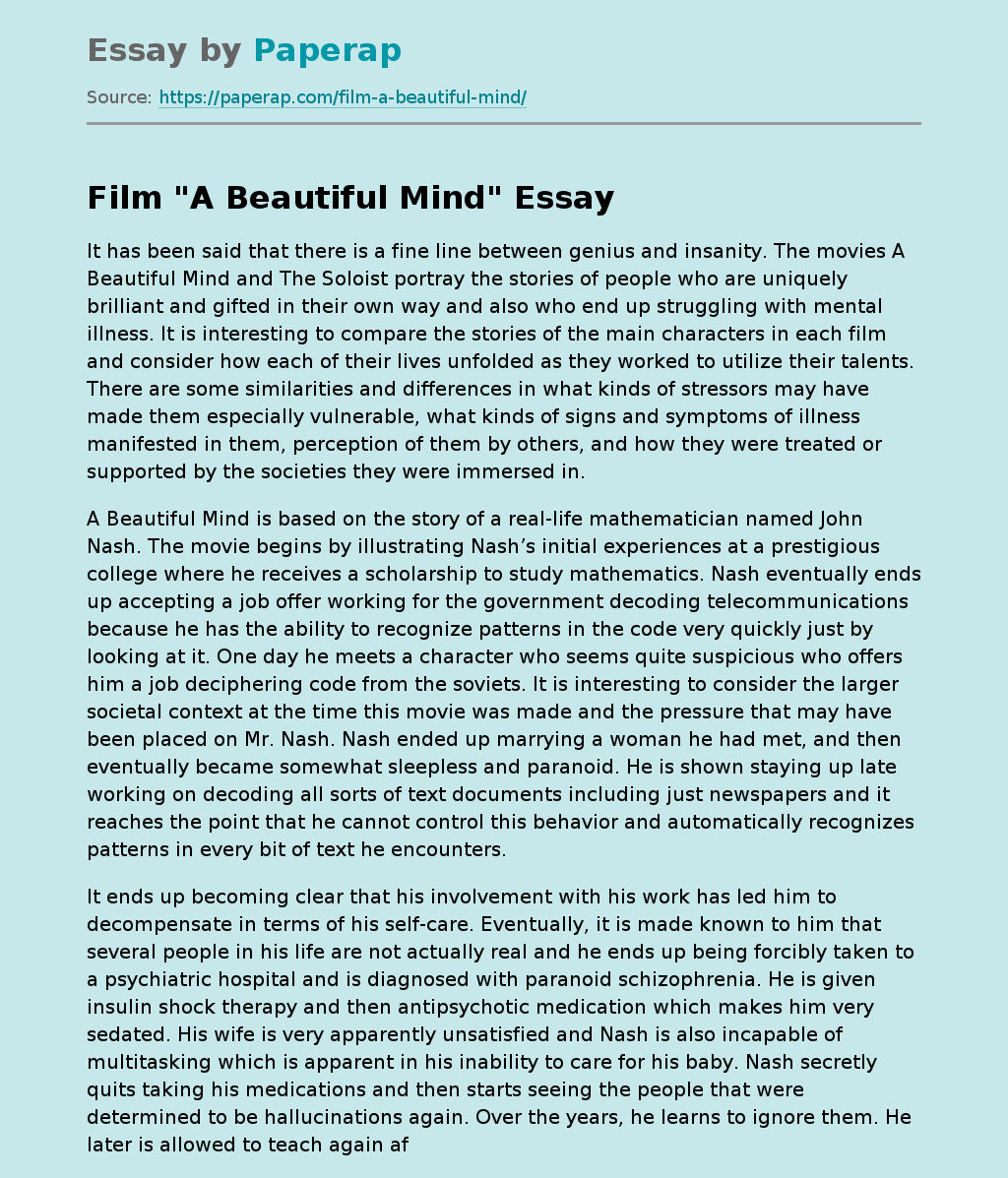Film "A Beautiful Mind"
It has been said that there is a fine line between genius and insanity. The movies A Beautiful Mind and The Soloist portray the stories of people who are uniquely brilliant and gifted in their own way and also who end up struggling with mental illness. It is interesting to compare the stories of the main characters in each film and consider how each of their lives unfolded as they worked to utilize their talents. There are some similarities and differences in what kinds of stressors may have made them especially vulnerable, what kinds of signs and symptoms of illness manifested in them, perception of them by others, and how they were treated or supported by the societies they were immersed in.
A Beautiful Mind is based on the story of a real-life mathematician named John Nash. The movie begins by illustrating Nash’s initial experiences at a prestigious college where he receives a scholarship to study mathematics. Nash eventually ends up accepting a job offer working for the government decoding telecommunications because he has the ability to recognize patterns in the code very quickly just by looking at it.
One day he meets a character who seems quite suspicious who offers him a job deciphering code from the soviets. It is interesting to consider the larger societal context at the time this movie was made and the pressure that may have been placed on Mr. Nash. Nash ended up marrying a woman he had met, and then eventually became somewhat sleepless and paranoid.
He is shown staying up late working on decoding all sorts of text documents including just newspapers and it reaches the point that he cannot control this behavior and automatically recognizes patterns in every bit of text he encounters.
It ends up becoming clear that his involvement with his work has led him to decompensate in terms of his self-care. Eventually, it is made known to him that several people in his life are not actually real and he ends up being forcibly taken to a psychiatric hospital and is diagnosed with paranoid schizophrenia. He is given insulin shock therapy and then antipsychotic medication which makes him very sedated. His wife is very apparently unsatisfied and Nash is also incapable of multitasking which is apparent in his inability to care for his baby. Nash secretly quits taking his medications and then starts seeing the people that were determined to be hallucinations again. Over the years, he learns to ignore them. He later is allowed to teach again after being able to learn to function while not on medications. When he was on the medication he was not able to successfully do his job. Eventually, he wins the Nobel Prize.
In The Soloist, which is also based on a true story, Nathanial Ayers is introduced as a homeless man who is playing the violin when he is encountered by a journalist for the LA Times. The journalist speaks with him and realizes that he had previously attended the Julliard School of Music. The journalist investigates Ayers’ story and meets with him several times trying to understand the story of his life. It is eventually illustrated that he had a psychotic episode of sorts while attending school. It is also shown that before he became explicitly psychotic he had started to decompensate in terms of his psychological well-being when he started neglecting his sleep in order to play the cello. This is very similar to what Nash in A Beautiful Mind experienced. One interesting part of Ayers’ story, however, is how he is portrayed to have had a psychotic episode that was very terrifying for him while living alone and how this led to him not wanting to live in an apartment again. He eventually finds great solace in taking cello lessons but then has a very challenging time with the recital—seeming to get overwhelmingly anxious and running away from the recital.
Both A Beautiful Mind and The Soloist portray individuals with schizophrenia. Both characters struggle with somewhat of altered perception that generates in their fear and anxiety. Both Nash and Ayers are uniquely talented in a realm that they become wrapped up in and then they are shown staying up all night committed to their respective passions prior to experiencing their “psychotic breaks.” Each film portrays the great struggle that each man endured and illustrated their vulnerabilities during these times. They also illustrated how difficult it was for the people who tried to help them as well as the resistance that they expressed towards these people. They each found ways to cope—and for each of them the resilience-building approach focused on embracing the natural gifts that they were most passionate about. This may be what I loved about these movies the most—they portrayed how it was Nash and Ayers’ passions that led to their decompensation, but also it was these passions that rehabilitated them as well—thereby pointing out the crucial role played by basic everyday health determinants including sleep hygiene on mental illnes
Film "A Beautiful Mind". (2021, Dec 13). Retrieved from https://paperap.com/film-a-beautiful-mind/

